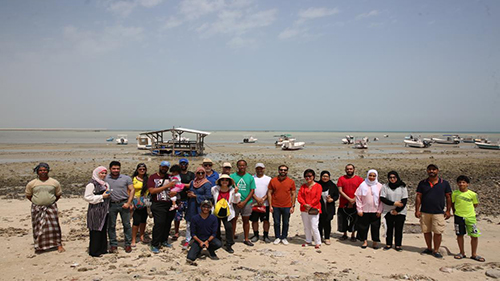Contact Center
.
20 April 2019
Bahrain Culture’s Traditional Fisheries Tour, Around Qala’at al- Bahrain


Bahrain Authority for Culture & Antiquities, as part of the 14th Spring of Culture festival, organized a tour visit to the Haddrah (fishing traps laid out at sea) around the Qal'at al Bahrain coastline. The participants had the opportunity to discover the traditional fishing methods, learned how to make traditional fish traps ( Haddrah) from natural materials in the surrounding area and ways of searching for oysters and pearl hunting.
The tour aimed to give an insight into the sustainable traditional fishing methods, such as the wire (gargoor) and barrier (haddrah) traps, given that as an island nation renowned for its seafaring-related activities, fishermen have been plying their trade in Bahrain’s waters for many millennia. Among the prized items in the toolbox of any fishermen is the “fish traps” –considered a prized item in the toolbox of any fisherman. Traditionally made from local palms and reeds, Fish Traps are deposited in various locations, where their clever funnel shape allows fish in but prevents them from escaping. There is no doubt that fishing is considered a significant economic activity in Bahrain, seen often as being of heritage value since the early fishing and trading activities’ times.
The tour started by an introduction to the to making of traditional fish traps, Gargoor, wire traps or ‘gargoor’, and fixed intertidal stake nets, still used as entirely artisanal in nature. These methods of fisheries are undoubtedly are entirely artisanal in nature and marine environment friendly ways to earn a living from fishing.
The tour also shed lights on ‘haddrah’, fishing methods, is an inter-tidal fixed stake trap, and a traditional fishing gear in Bahrain. Although their technologies differ across geographies, their basic purpose is to capture fish by limiting their movement without greatly impeding water flow. In the case of intertidal weirs, fish swimming parallel to shore at high tide encounter the " wing " and invariably try to escape by swimming into deeper water, eventually entering a smaller enclosure where they are captured by the receding tides. Hadrahs are made of three parts: the fence, known as the yad is placed perpendicular to the shore and leads into the hawsh, a gathering corral, which in turn leads into the sir, the final catchment area or pocket located at or just below the low tide mark.
The tour also included collecting many oysters, showing participants how to open them, how to look for pearls inside, exhibiting some genuine natural pearls, that flourish in a well-determined and precise warm tidal water environment.







